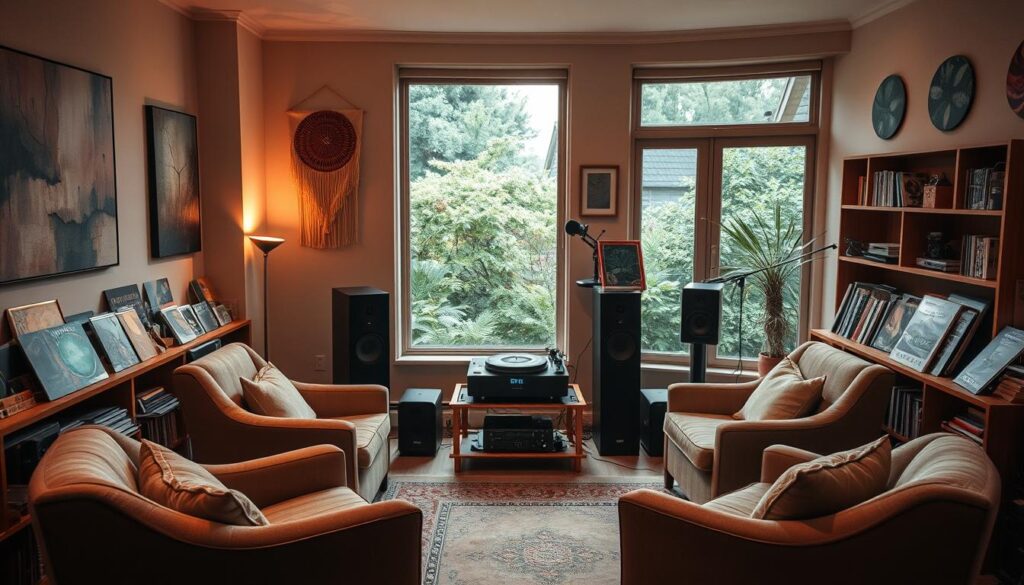Modern life presents many challenges that can impact a person’s well-being. Feelings of worry and tension are increasingly common in today’s fast-paced world. Many individuals seek accessible methods to manage these emotions and improve their daily experience.
Sound and rhythm offer a powerful, evidence-based approach to calming the mind. This form of intervention can quickly influence mood and reach the subconscious. It is a tool that is both inexpensive and readily available for integration into daily routines.
This guide explores specific auditory strategies supported by scientific research. It outlines various approaches that provide tangible benefits for both mental and physical health. The goal is to offer practical solutions for navigating contemporary challenges.
Understanding how to use these methods effectively can lead to a more balanced life. The following sections will provide a comprehensive look at how to harness this natural resource for better well-being.
Understanding the Power of Music on Stress and Anxiety
Research demonstrates that specific sound frequencies can actively reshape neural pathways and emotional responses. The connection between auditory input and psychological states is both immediate and profound.
How Music Influences the Brain and Emotions
Different tempos produce distinct effects on the mind and body. Faster rhythms can enhance alertness and improve concentration. Slower beats encourage mental quieting and muscle relaxation.
When listening to tracks around 60 beats per minute, brain activity synchronizes with the rhythm. This synchronization promotes alpha brainwaves, which are associated with relaxed awareness. The process occurs naturally within minutes of exposure.
Scientific Research and Proven Benefits
A 2013 review published in Frontiers in Psychology revealed significant findings. Listening to appropriate sounds can lower cortisol levels by up to 61%. Cortisol is a key biological marker of tension.
In a 2019 PLoS One study, 89% of participants reported substantial improvements in their emotional state. University of Nevada research showed that 75% of subjects experienced relaxed alpha wave patterns after just five minutes. These effects contribute to better overall health.
The evidence clearly shows how auditory experiences can positively impact mental health. This understanding provides a foundation for practical applications discussed later.
Getting Started: Setting Up Your Musical Environment
Setting up an optimal listening environment requires careful consideration of both space and equipment. The physical surroundings where sounds are experienced can dramatically influence their effectiveness. Creating the right atmosphere is the first step toward meaningful auditory experiences.
Designing a Space for Relaxation
Choose locations with attention to acoustic qualities. Loud environments contribute to tension buildup, even when ignored. Quieter settings with soothing sounds promote natural relaxation.
Dedicate a comfortable area free from distractions. Consider lighting, seating, and acoustics. This space becomes a sanctuary for daily listening practice.
Choosing the Right Devices and Tools
Modern technology makes personal audio libraries accessible anywhere. High-quality headphones or speakers enhance the experience. Streaming services and portable devices offer convenience.
Select equipment that suits individual preferences and lifestyle. The right tools make it easy to incorporate sounds into daily routines. This foundation prepares for deeper engagement with auditory wellness practices.
Implementing Stress Relief Music Techniques

Integrating auditory practices into daily routines can create powerful shifts in emotional well-being. These approaches work by engaging the subconscious mind where patterns of worry often reside. The methods are accessible and can be adapted to individual preferences.
Step-by-Step Guide to Using Music for Relaxation
Begin by identifying key moments in your day that benefit from auditory support. Morning transitions set the tone for hours ahead. Evening routines help calm the nervous system before sleep.
Replace jarring alarms with gentle, familiar tracks. This creates a smoother transition into waking consciousness. The approach prevents immediate tension activation upon waking.
Singing aloud during showers or commutes regulates breathing patterns. Vocalization naturally slows respiratory rates. This physiological change supports overall calm.
Playing an instrument engages multiple brain areas simultaneously. Even brief sessions provide comprehensive mental stimulation. The activity serves as cognitive exercise while promoting peace.
Combine positive affirmations with melody to create musical mantras. This technique helps reprogram negative thought patterns. The combination makes positive messages more memorable and effective.
Incorporate sound into physical activities for enhanced benefits. The synergy between movement and rhythm amplifies both physical and psychological effects. This creates a more holistic wellness practice.
These strategies demonstrate how therapeutic principles can be applied informally. The accessible nature of these methods makes them suitable for various lifestyles. Consistent practice yields the most significant improvements in daily experience.
Crafting Your Perfect Stress-Reducing Playlist

The art of playlist creation offers a powerful method for shaping one’s daily emotional landscape. Building a personalized collection allows individuals to curate their auditory environment with intention.
Selecting Soothing Songs and Melodies
Begin by reflecting on personal emotional responses to different genres. Identify which tracks elevate your mood or promote calm. Consider slower tempos around 60 beats per minute for maximum effect.
Instrumental selections often work best for mental quieting. They eliminate potentially distracting lyrics while maintaining emotional resonance. Gentle melodies and soft instrumentation create an atmosphere of tranquility.
Structuring Your Playlist for Daily Use
Organize your playlist to match daily rhythms. Morning selections might include uplifting favorite tunes. Evening tracks should feature more calming, relaxing music.
Create smooth transitions between songs to maintain emotional flow. Consider these playlist purposes:
- Focus and concentration
- Physical activity support
- Evening wind-down routines
- Background ambiance
The most effective playlist reflects personal taste while incorporating evidence-based principles. Regular updates prevent habituation and maintain the collection’s emotional impact.
Leveraging Music for Physical Movement and Relaxation

Combining physical activity with auditory stimulation creates a powerful synergy for overall wellness. This approach addresses both mental and physical aspects simultaneously.
Movement serves as an excellent method to release accumulated tension in the body. When paired with rhythmic sound, the effect becomes significantly enhanced. The combination creates a comprehensive approach to daily well-being.
Dance, Exercise, and Movement to Enhance Benefits
Dancing to rhythmic patterns offers exceptional advantages for both cognitive function and mood elevation. A 2003 New England Journal of Medicine report highlighted how dancing with music can improve mental sharpness.
During workouts, auditory elements can boost stamina and performance. They make physical exertion feel more enjoyable and less strenuous. This natural partnership helps maintain consistent exercise habits.
The Connection Between Music and Physical Well-Being
The 3Ms formula—Music, Movement, and Meditation—provides a structured approach to daily wellness. Just 10-20 minutes of each component can create transformative results.
Physical activity helps eliminate lactic acid buildup that contributes to discomfort. When supported by appropriate soundtracks, the process becomes more effective and enjoyable.
This integrated approach offers significant benefits for long-term health maintenance. It represents a practical way to incorporate wellness into busy schedules.
Active Listening: Engaging with Music Mindfully
The practice of mindful listening transforms the experience of sound from passive to active. This approach requires a deliberate shift in attention, moving beyond having tunes in the background.
This form of engagement activates more brain areas than casual listening. It creates a deeper resonance within the body, leading to a more powerful effect on one’s emotional state.
Techniques to Fully Immerse Yourself in the Sound
To begin, find a quiet space free from interruptions. Choose a slower piece of music that feels personally meaningful. This sets the stage for a successful session.
Close your eyes and consciously slow your breathing. Focus your mind on a single element within the composition. You might follow the melody or a specific instrument.
This focused attention trains the mind to be present. Even a short period of time dedicated to this way of listening music can recharge your mental energy.
For optimal conditions, consider these tips:
- Use quality headphones to enhance the sonic experience.
- Adopt a comfortable posture, either sitting or lying down.
- Allow yourself to be fully absorbed in the journey of the sound.
The quality of this listening music practice matters greatly. Intentional engagement yields significantly greater benefits for mental clarity and a calm state of being.
Using Singing and Instrumental Play for Stress Relief

Active participation in creating sound offers a unique pathway to wellness. This approach moves beyond passive listening into a realm of personal expression.
Engaging in this way can be a powerful form of therapy. It allows individuals to channel their energy positively.
The Therapeutic Role of Singing Aloud
Vocal expression is a natural tool for emotional release. Singing aloud helps regulate breathing patterns, which calms the nervous system.
People can sing anywhere—in the shower, car, or as a bedtime routine. It’s not about performance quality. The goal is the sensation of melody moving through the body.
After a few minutes, notice how you make feel different. Identify songs that create positive shifts for future use.
Playing an Instrument as a Form of Expression
Instrumental play engages multiple brain areas simultaneously. It acts like a comprehensive mental workout.
Both beginners and experienced musicians can benefit. The key is to approach it as “playing” not “working”. This avoids frustration.
Joining a group activity, like a drum circle or choir, adds a social healing component. It creates a supportive environment for expression.
This active music creation provides a direct channel for emotional release. It is a valuable part of any wellness routine.
Creating a Sonic Environment at Home and Work

The acoustic landscape of our daily environments significantly influences our mental state and productivity. Thoughtful sound design can transform challenging spaces into supportive ones.
Optimizing Background Music for Better Focus
Workplaces often present complex interpersonal dynamics that affect everyone’s day. The right background audio helps people complete routine tasks with improved mood.
Soothing sounds mask distracting noises in busy environments. This creates better conditions for sustained attention during work time.
Breaks become more restorative when accompanied by inspiring selections. These moments recharge mental systems, making it easier to manage stress throughout the day.
Different people have unique audio preferences. What relaxes one person might irritate another. Sharing musical discoveries can build understanding between colleagues.
In shared spaces like offices or libraries, headphones respect others’ needs. Research shows appropriate background sound can enhance productivity when used thoughtfully.
Establishing music daily as part of life routines creates consistent supportive environments. This approach helps people navigate various settings more effectively.
Scientific Evidence Behind Music’s Stress-Reducing Effects
Multiple clinical studies have quantified the measurable effects of sound-based approaches on biological markers. These investigations provide concrete data supporting auditory interventions for emotional well-being.
Research Findings and Key Statistics
A landmark 2013 review revealed significant cortisol level reductions. This hormone serves as a key indicator of tension in the body.
University research demonstrated brainwave changes within minutes of exposure. These shifts promote relaxed mental states that support overall health.
Clinical music therapy sessions show impressive results across diverse populations. The approach helps people manage various emotional challenges effectively.
British research found that daily listening produces consistent wellness benefits. Participants reported improved quality of life through regular practice.
These findings encourage individuals to experiment with different auditory approaches. Personal discovery leads to optimal emotional balance and cardiovascular health.
Embracing Music: The Journey to a Calmer Mind
Discovering what truly resonates with an individual’s unique needs transforms routine listening into a therapeutic practice. This music powerful connection between sound and serenity represents a deeply personal exploration. People can use music as a natural resource for improving their daily experience.
Paying attention to how one feels before, during, and after musical experiences reveals what works best. Creating personalized playlists based on these discoveries ensures effective mood improvement. Simple applications like playing classical music during meals or establishing bedtime routines with relaxing music create consistent benefits.
This approach to wellness blends artistic expression with scientific understanding. The journey toward better mental health continues as people refine their musical choices over time. Embracing this practice leads to a calmer mind and enhanced quality of life.





